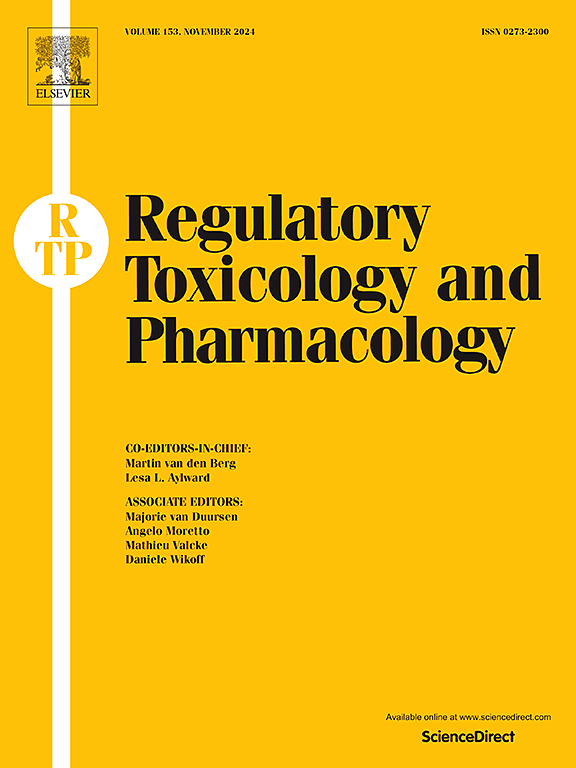减少使用非人类灵长类动物开发具有细胞毒性有效载荷的肿瘤adc的策略。
IF 3.5
4区 医学
Q1 MEDICINE, LEGAL
引用次数: 0
摘要
在生物制剂的非临床开发中使用非人类灵长类动物(NHP)可能是评估人类潜在安全风险的必要条件。IQ DruSafe工作组(WG)对NHP在毒理学研究中的应用进行了调查,该毒理学研究用于开发具有细胞毒性有效载荷的用于肿瘤治疗的抗体药物偶联物(adc)。该调查探讨了良好实验室规范(GLP) 3个月NHP研究是否提供了相对于1个月GLP NHP或相对于3个月GLP啮齿动物研究的额外安全信息。调查中的问题包括是否进行了为期3个月的NHP研究,如果进行了,结果是否与为期3个月的啮齿动物研究或1个月的NHP研究相似,观察到的毒性是否与ADC有效载荷的预期毒性一致,以及毒性是否转化为临床观察到的毒性。此外,调查问题涉及研究设计元素,特别是与研究中使用的动物数量有关的元素。调查结果表明,不同研究之间的靶器官毒性大体相似,可转化为人类,并且大多数归因于有效载荷。总的来说,调查结果支持在肿瘤学中具有细胞毒性有效载荷的adc开发中减少NHP使用的机会。本文章由计算机程序翻译,如有差异,请以英文原文为准。
Strategies to reduce the use of non-human primates in development of oncology ADCs with cytotoxic payloads
The use of non-human primates (NHP) for the nonclinical development of biologics can be necessary to assess the potential safety risks in humans. An IQ DruSafe and 3Rs TPS Working Group (WG) conducted a survey on the use of NHP in toxicology studies used to develop antibody drug conjugates (ADCs) with cytotoxic payloads for oncology treatment. The survey addressed whether a Good Laboratory Practice (GLP) 3-month NHP study provides additional safety information relative to the 1-month GLP NHP or relative to the 3-month GLP rodent study. Questions from the survey included whether a 3-month NHP study was conducted and if so, were the results similar or not to the 3-month rodent study or the 1-month NHP study, if the toxicities observed were consistent with the expected toxicities of the ADC payload, and whether the toxicities translated to that observed in the clinic. In addition, survey questions addressed study design elements particularly related to the number of animals used in studies. Survey results indicated that target organ toxicities were generally similar between studies, were translatable to humans, and most were attributed to the payload. Overall, the survey results support opportunities to reduce NHP use in the development of ADCs with cytotoxic payloads in oncology.
求助全文
通过发布文献求助,成功后即可免费获取论文全文。
去求助
来源期刊
CiteScore
6.70
自引率
8.80%
发文量
147
审稿时长
58 days
期刊介绍:
Regulatory Toxicology and Pharmacology publishes peer reviewed articles that involve the generation, evaluation, and interpretation of experimental animal and human data that are of direct importance and relevance for regulatory authorities with respect to toxicological and pharmacological regulations in society. All peer-reviewed articles that are published should be devoted to improve the protection of human health and environment. Reviews and discussions are welcomed that address legal and/or regulatory decisions with respect to risk assessment and management of toxicological and pharmacological compounds on a scientific basis. It addresses an international readership of scientists, risk assessors and managers, and other professionals active in the field of human and environmental health.
Types of peer-reviewed articles published:
-Original research articles of relevance for regulatory aspects covering aspects including, but not limited to:
1.Factors influencing human sensitivity
2.Exposure science related to risk assessment
3.Alternative toxicological test methods
4.Frameworks for evaluation and integration of data in regulatory evaluations
5.Harmonization across regulatory agencies
6.Read-across methods and evaluations
-Contemporary Reviews on policy related Research issues
-Letters to the Editor
-Guest Editorials (by Invitation)

 求助内容:
求助内容: 应助结果提醒方式:
应助结果提醒方式:


